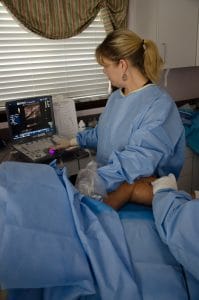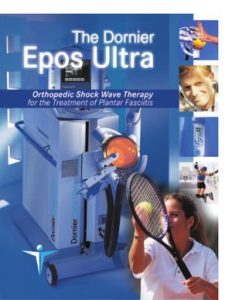
Plantar Fasciitis Surgery
In general,surgery is not needed to treat cases of plantar fasciitis. Approximately 95% of those suffering from plantar fasciitis are able live a life free from heel pain without resorting to surgery. However, your healthcare provider might deem surgery necessary if you have exhausted nonsurgical treatment options with no success. He or she may also consider it, if the heel pain is lowering your quality of life by restricting your daily activities. It is standard for doctors to first attempt nonsurgical treatment options for 6 to 8 months before even considering surgery as an option.
Most doctors will recommend one of two types of surgery for plantar fasciitis. They are:
- Plantar fascia release. This is the most common procedure and involves trimming the plantar fascia ligament to release tension on the ligament relieving inflammation. The surgeon may decouple the heel bone and the plantar fascia. Alternatively he or she may make a pair of incisions on either side to release the tension. During the surgery, the doctor will make an incision above the heel pad on the foot or on the bottom of the foot. Many surgeons prefer the back of the heal because it allows you to return to walking more quickly.
- Additional procedures may be done at the same time as the plantar fascia release if there is a history of heel pain or additional problem in the heel such as a heel spur. Heel spurs are tiny growths of bone on the heel that can cause pain and inflammation. In the past, experts believed that heel spurs were one of the causes of plantar fasciitis. There is now new evidence that suggests that the development of heel spurs are a result, and not a cause, of plantar fasciitis.
Recovery For Plantar Fasciitis Release
Normally people with plantar fasciitis need at least 6 months to fully recover!
However, since you have taken the plantar fasciitis releases surgery you will have a completely different recovery.
Therefore your recovery time will be only 6 to 10 weeks.
In the first 4 weeks, your doctor may recommend physical therapy to improve your flexibility and strength.
After 10 weeks you will be able to walk without any help, which means you will be fully recovered from plantar fasciitis.
If you had a minimally invasive surgery then you may have a faster recovery but if not then you will need to wait for at least 3 weeks to return to normal your schedule.
You should return to more vigorous activities after full recovery or you may damage your fascia again.
Does Plantar Fasciitis Release Have Any Side Effects?
Just like every other surgery plantar fasciitis release comes with some side effects, for example, if you start high-pressure exercises early then you may damage your fascia even more.
There are some more risks and side effects, some of them include:
• If plantar fasciitis release was too much then the arch may decrease
• You may develop numbness in the feet because some nerves may get damaged during the surgery.
• If you don’t care about your surgery site and forget to clean it then an infection may arise.
How To Prevent Plantar Fasciitis In the Future?
Here are some of the most useful tips that can help you prevent this problem in the future:
• Do not forget to stretch before exercises
• Maintaining a healthy weight, it’s the leading cause of plantar fasciitis
• Choose supportive shoes
• Avoiding wearing old shoes, change to new ones
• Avoid standing still for long periods, applying pressure on your feet causes foot problems.
How can patients manage pain and discomfort after plantar fasciitis surgery?
Patients can manage pain and discomfort after plantar fasciitis surgery through a variety of methods, including:
- Medications: Over-the-counter pain relievers such as ibuprofen or acetaminophen can help reduce pain and inflammation. Your doctor may also prescribe stronger pain medications if needed.
- Rest and Elevation: Resting the affected foot and elevating it above the level of the heart can help reduce swelling and alleviate pain.
- Ice Therapy: Applying ice packs to the affected area for 15-20 minutes several times a day can help reduce pain and swelling.
- Compression: Using compression bandages or socks can help reduce swelling and provide support to the foot.
- Physical Therapy: Your doctor may recommend physical therapy exercises to help strengthen the muscles in your foot and improve flexibility.
- Orthotic Devices: Custom orthotic devices or shoe inserts can help support the arch of the foot and reduce strain on the plantar fascia.
Are there any factors that may affect the outcome of plantar fasciitis surgery?
Yes, several factors can affect the outcome of plantar fasciitis surgery, including:
- Severity of the Condition: The severity of the plantar fasciitis, including the extent of tissue damage and the presence of heel spurs, can impact the surgical outcome.
- Underlying Health Conditions: Certain health conditions, such as diabetes, obesity, or autoimmune disorders, can affect the healing process and increase the risk of complications.
- Smoking: Smoking can impair circulation and hinder the healing process, potentially affecting the outcome of surgery.
- Compliance with Postoperative Care: Following postoperative care instructions, such as wearing a splint or brace, performing recommended exercises, and attending follow-up appointments, is crucial for a successful outcome.
- Activity Level: Engaging in high-impact activities too soon after surgery can compromise the surgical outcome and increase the risk of complications.
Plantar Fasciitis: Should I Have Surgery for Heel Pain?
Additional Treatment Option

ESWT (extracorporeal shock wave therapy) is a new procedure that uses pulsating sonic waves to treat plantar fasciitis. While much research is still being completed, early studies indicate that ESWT can possibly play a role in reducing symptoms in plantar fasciitis, especially in cases that have not yet responded to other forms of treatment. Research is also underway for additional shock wave therapies. These shock wave therapies, often referred to as “focused” ESWT, may require local anesthetic. While in “radial” ESWT (a different class of shock wave treatment) the waves are more spread out and therefore can be done without anesthetic.
